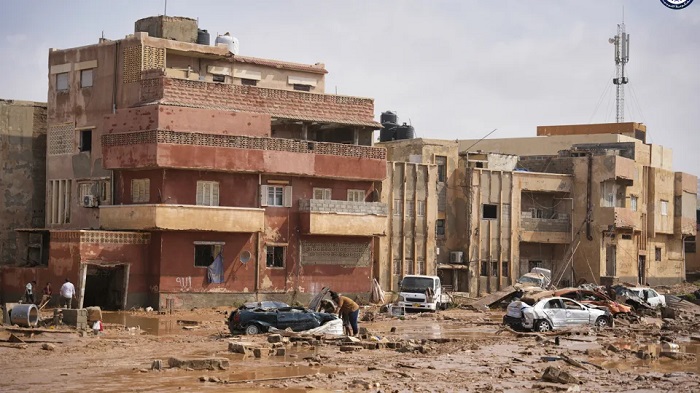
Thousands of people are feared dead in Libya after Storm Daniel brought so much rain to the northeast that two dams collapsed in one region, sweeping entire neighborhoods into the sea.
More than 2,000 people have died and about 6,000 more are missing in the badly affected city of Derna, where two dams collapsed under the pressure of flooding, according to Ahmed Mismari, spokesperson for the eastern based Libyan National Army (LNA).
“As a consequence, three bridges were destroyed. The flowing water carried away entire neighborhoods, eventually depositing them into the sea,” he said.
CNN has not been able to independently verify the number of deaths, and Mismari did not give a source for the number of dead and missing.
The Red Crescent in Benghazi earlier estimated 150 to 250 people are dead in Derna, according to Reuters.
The head of Libya’s Emergency and Ambulance authority, Osama Aly, told CNN that after the dam collapse “all of the water headed to an area near Derna, which is a mountainous coastal area.”
Homes in valleys were washed away by strong muddy currents carrying vehicles and debris, he added. Phone lines in the city are also down, complicating rescue efforts, Aly said, with workers unable to enter Derna due to the heavy destruction.
Aly said authorities didn’t anticipate the scale of the disaster.
“The weather conditions were not studied well, the seawater levels and rainfall [were not studied], the wind speeds, there was no evacuation of families that could be in the path of the storm and in valleys,” Aly said.
“Libya was not prepared for a catastrophe like that. It has not witnessed that level of catastrophe before. We are admitting there were shortcomings even though this is the first time we face that level of catastrophe,” Aly told Al Hurra channel earlier.
Mismari, the LNA spokesperson, said the floods have affected several cities, including Al-Bayda, Al-Marj, Tobruk, Takenis, Al-Bayada, and Battah, as well as the eastern coast all the way to Benghazi.
‘Unprecedented floods’
Libya, a country of six million people, has been split between warring factions since 2014, following the 2011 NATO-backed uprising against Moammar Gadhafi.
The head of Libya’s eastern parliament-backed government, Osama Hamad, described the situation as “catastrophic and unprecedented,” according to a report from state news organization Libyan News Agency (LANA).
Footage shared on social media showed submerged cars, collapsed buildings and torrents of water rushing through streets.
Hospitals in the eastern city of Bayda were evacuated after severe flooding from rainfall caused by a heavy storm, videos shared by the Medical Center of Bayda on Facebook showed.
“The United Nations in Libya is closely following the emergency caused by severe weather conditions in the eastern region of the country,” said the United Nations Support Mission in Libya in a post on X.
Several countries have sent their condolences and offered aid to Libya as rescue teams scramble to find survivors under the debris and rubble.
Turkey’s disaster agency saying Monday that it will mobilize 150 search and rescue personnel, along with tents, rescue vehicles and other supplies such as generator.
The US Embassy in Libya said on X, formally known as Twitter, that it was in “close contact with the United Nations and with authorities in Libya to determine how quickly we can bring assistance to bear where it is most needed.”
United Arab Emirates President, Zayed Al Nahyan, has directed to send aid and search and rescue teams while offering his condolences to those affected by the catastrophe, state news agency reported.
Egypt’s President Abdel-Fattah El-Sisi also extended his condolences to Libya. “I wish a speedy recovery for the injured, and I hope that the crisis will pass quickly with Libyans standing together in unity,” El-Sisi said in a statement on social media.
The weekend’s rain is the result of the remnants of a very strong low-pressure system, which was officially named Storm Daniel by the national meteorological services in southeastern Europe.
The storm brought catastrophic flooding to Greece last week before moving into the Mediterranean and developed into a tropical-like cyclone known as a medicane. These systems can bring dangerous conditions to the Mediterranean Sea and coastal countries, similar to tropical storms and hurricanes in the Atlantic or typhoons in the Pacific.
The remains of the storm are affecting northern Libya and will slowly head east toward northern Egypt. Rainfall for the next two days could reach 50mm – this region averages less than 10mm across the whole of September. (CNN)


